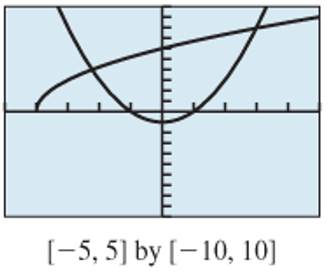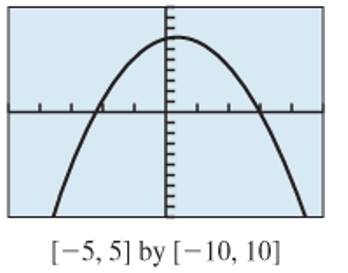
Concept explainers
a.
The two equations that are graphed in the given image.
The parabolic graph is
Given:
The graph to solve the equation

Concept Used:
- The graph of a quadratic function is U shaped.
- The graph of an even order radical function can take values that are greater than or equal to 0 only.
Calculation:
In the given graph, note that there are two graphs, one is an upward opening parabola and the other graph is starting from the horizontal axis and moving upward.
To solve the given equation,
Since the left hand side expression is an square root function, its graph will start from horizontal axis and move upward and the right side expression is a quadratic function, so its graph will be a parabola.
Thus, the parabolic graph is
b.
The two equations that are graphed in the given image.
The equation graphed is
Given:
The graph to solve the equation

Concept Used:
- The graph of a quadratic function is U shaped.
- The graph of an even order radical function can take values that are greater than or equal to 0 only.
Calculation:
In the given graph, note that there is only one graph and it intersecting the horizontal axis at two points.
To solve the given equation,
Thus, the equation graphed is
c.
How the intersection point in figure (a) related to the x -intercept in figure (b).
The intersection points in figure (a) are same as the x -intercepts in figure (b).
Given:
The graphs to solve the equation
Concept Used:
- The graph of a quadratic function is U shaped.
- The graph of an even order radical function can take values that are greater than or equal to 0 only.
Calculation:
From the figure (a) and figure (b), note that the intersection points of figure (a) are exactly the same as the x -intercepts of the figure (b) as they both giving the solutions of the same equation.
Thus, the intersection points in figure (a) are same as the x -intercepts in figure (b).
Chapter P Solutions
PRECALCULUS:GRAPHICAL,...-W/ACCESS
- Can you solve it numerical methodarrow_forwardUse the information to find and compare Ay and dy. (Round your answers to four decimal places.) Function x-Value Differential of x Ду = dy = y = x² + 2 x = -4 Ax = dx = 0.01arrow_forwardCalculus lll May I please have the statements with blank lines completed; furthermore, may I please have the text box completed? Thank youarrow_forward
- Calculus lll May I please have the statements completed for the following text lines and box? Thank you so much,arrow_forwardCalculus lll May I please have the solution for the following exercise? Thank you so mucharrow_forwardCalculus lll May I please have the solution for the following exercise? Thank you so much,arrow_forward
- Calculus lll May I please have the solution for the following exercise? Thank you so mucharrow_forwardCalculus lll May I please have the solution for the following example? Thank youarrow_forwardCalculus lll May I please have the statement completed for the following box? Thank you so much,arrow_forward
- Calculus lll May I please have the solution for the following exercise? Thank you so mucharrow_forwardUse a graphing calculator to find where the curves intersect and to find the area between the curves. y=ex, y=-x²-4x a. The left point of intersection is (Type integers or decimals rounded to the nearest thousandth as needed. Type an ordered pair.)arrow_forwardFind the area between the curves. x= -5, x=3, y=2x² +9, y=0 The area between the curves is (Round to the nearest whole number as needed.)arrow_forward
 Calculus: Early TranscendentalsCalculusISBN:9781285741550Author:James StewartPublisher:Cengage Learning
Calculus: Early TranscendentalsCalculusISBN:9781285741550Author:James StewartPublisher:Cengage Learning Thomas' Calculus (14th Edition)CalculusISBN:9780134438986Author:Joel R. Hass, Christopher E. Heil, Maurice D. WeirPublisher:PEARSON
Thomas' Calculus (14th Edition)CalculusISBN:9780134438986Author:Joel R. Hass, Christopher E. Heil, Maurice D. WeirPublisher:PEARSON Calculus: Early Transcendentals (3rd Edition)CalculusISBN:9780134763644Author:William L. Briggs, Lyle Cochran, Bernard Gillett, Eric SchulzPublisher:PEARSON
Calculus: Early Transcendentals (3rd Edition)CalculusISBN:9780134763644Author:William L. Briggs, Lyle Cochran, Bernard Gillett, Eric SchulzPublisher:PEARSON Calculus: Early TranscendentalsCalculusISBN:9781319050740Author:Jon Rogawski, Colin Adams, Robert FranzosaPublisher:W. H. Freeman
Calculus: Early TranscendentalsCalculusISBN:9781319050740Author:Jon Rogawski, Colin Adams, Robert FranzosaPublisher:W. H. Freeman
 Calculus: Early Transcendental FunctionsCalculusISBN:9781337552516Author:Ron Larson, Bruce H. EdwardsPublisher:Cengage Learning
Calculus: Early Transcendental FunctionsCalculusISBN:9781337552516Author:Ron Larson, Bruce H. EdwardsPublisher:Cengage Learning





